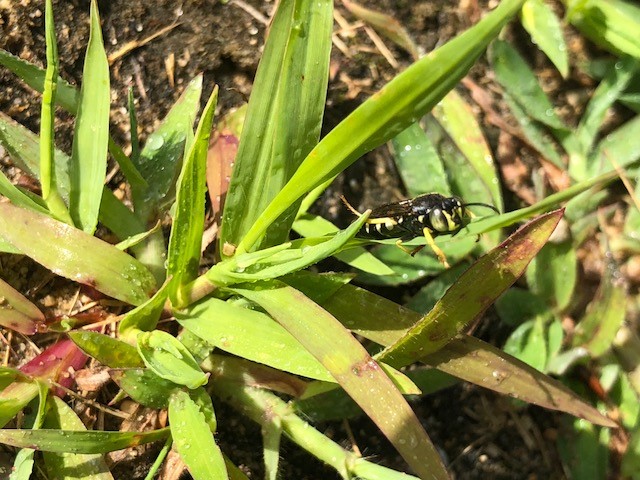Sand Wasps – not your average stinging insect
This week, I got two calls inquiring about wasps. The similarities in the calls were remarkable; in both cases, heavy wasp activity was noted in playgrounds with sand ground covers. The wasps had a very direct flight path, with only a couple seconds’ pause between landing and crawling down a tunnel or leaving a tunnel and taking flight. The flight itself was rapid, making it difficult to get a good look at the offending wasps. The first call described them as “looking like miniature cicada killers,” while the second managed to snap a photo to send my way for confident identification (see title photo).

These wasps are sand wasps, and in these cases they pose an interesting challenge. Sand wasps are solitary-gregarious wasps. There is no hive or colony; instead, every female builds her own nest, lays her own eggs, and stockpiles food for her own larvae. The nest is a chamber or series of chambers at the bottom of a burrow dug into sparsely vegetated or unvegetated sandy soil. Good nesting sites can be few and far between, and these wasps are very tolerant of neighbors, so when conditions are good a few hundred may pack into an area. They are not defensive, and will work around a person who strays into their territory rather than running them off or stinging. Their impressively speedy flight is important; most species of sand wasps specialize on a single type of prey, and a great many are particularly fond of flies. They paralyze their prey with a sting, then stockpile it in the nest as a food source for their developing larvae.
While sand wasps are typically docile, they can sting if provoked or handled roughly, as may happen if they are stepped on barefoot as they enter or leave a burrow. If they are out of the way in a low-traffic area, a live-and-let-live policy is probably best; after all, they’ll thin out blow flies and even horse flies that can be far more bothersome. However, large numbers of them in a playground presents a sting risk; playing children could easily dig up nests, swat at, or crush the wasps against their skin and get stung.
Because sand wasps each make their own nest and must make physical contact with a pesticide for it to work, pesticide treatments would need to be either applied to each individual nest or broadcast over the whole infected area. Depending on the residual activity of the pesticide and its ability to percolate through the sand, it may or may not affect wasps that are deep in their burrows or out foraging when the pesticide is applied. Changing the habitat is the most long-term solution to sand wasps. They need sandy soil with little to no vegetation covering, so adding a layer of topsoil over sand, planting more vegetation, or changing the ground cover to some non-sand cover can eliminate their habitat.






